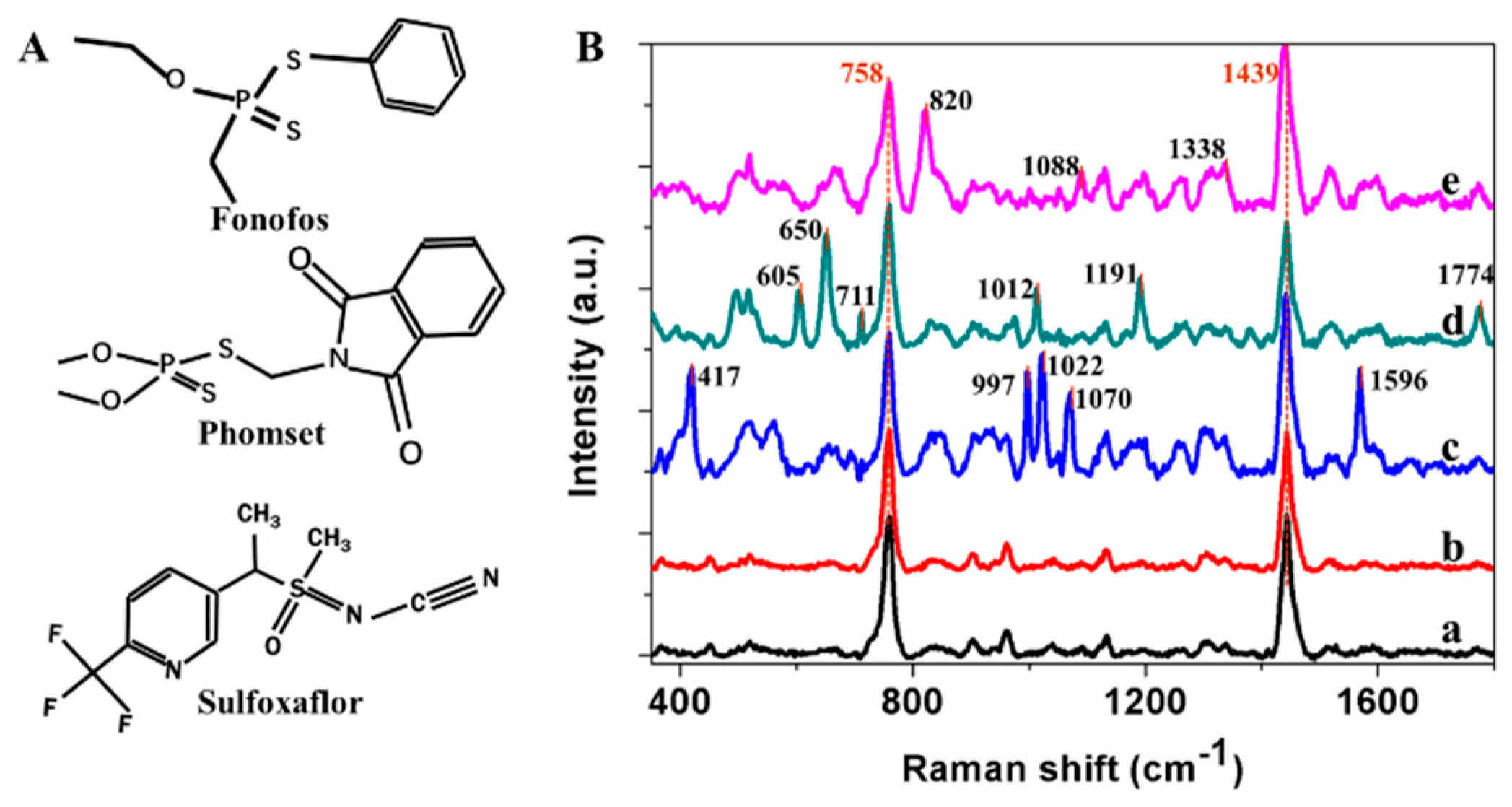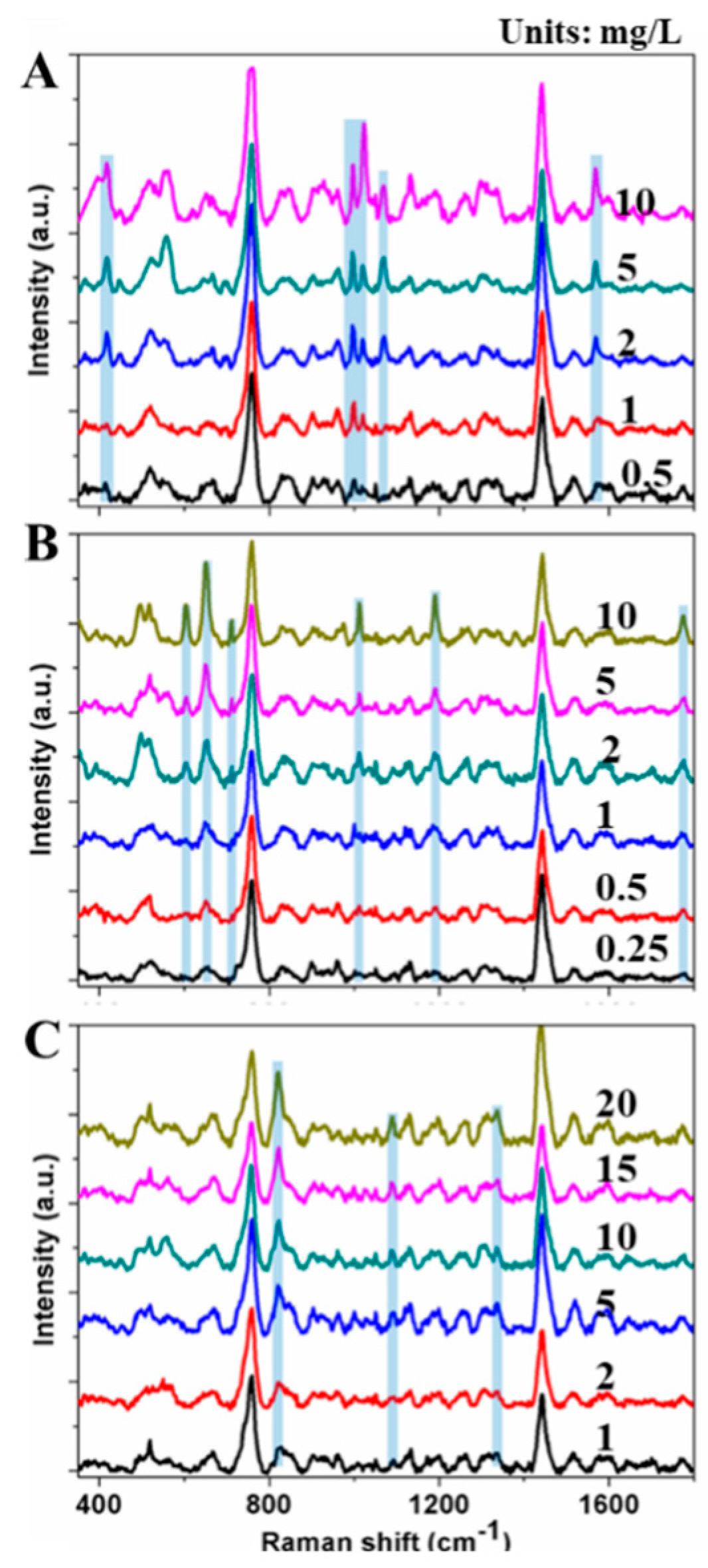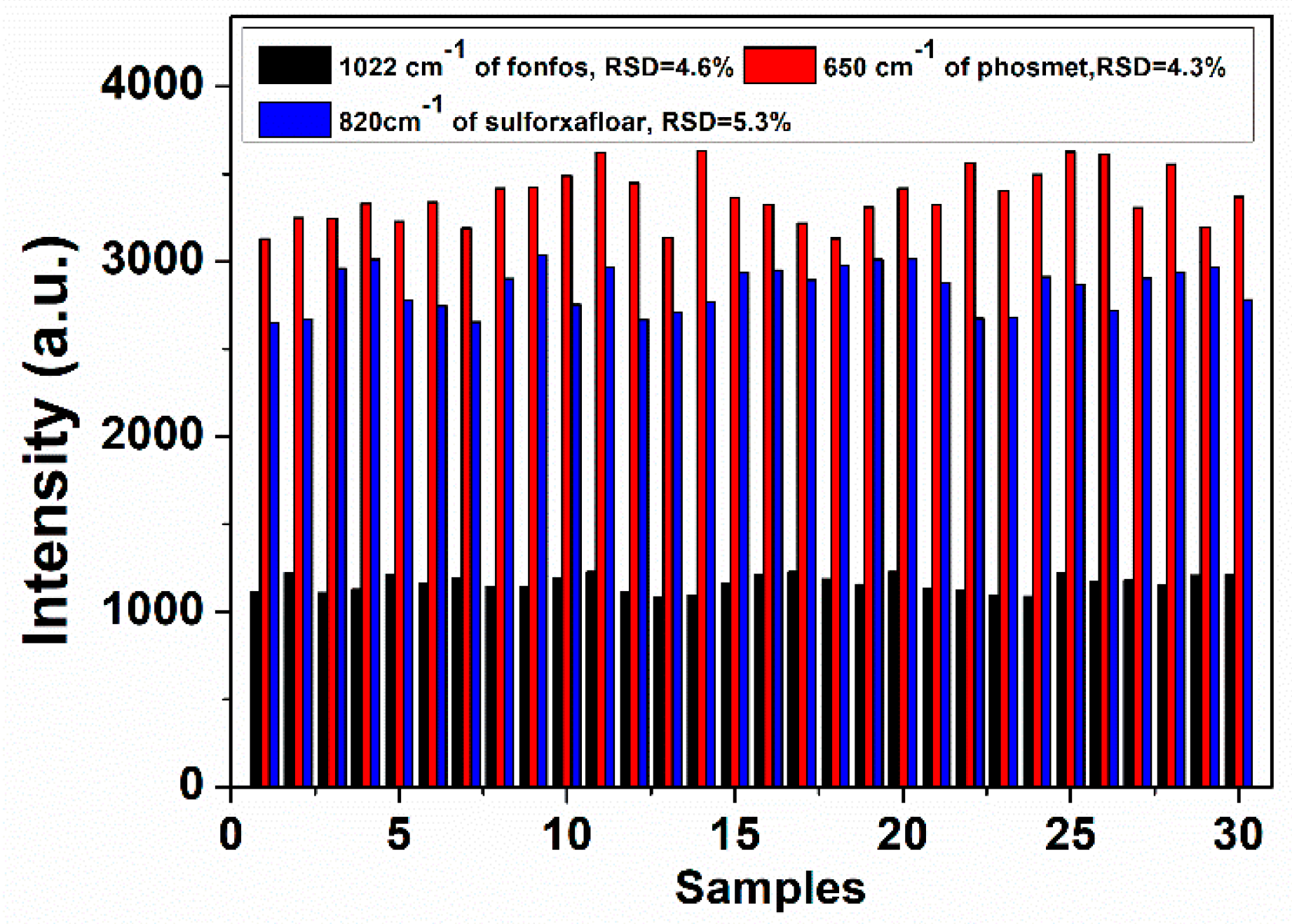Rapid Detection of Pesticide Residues in Paddy Water Using Surface-Enhanced Raman Spectroscopy
Abstract
1. Introduction
2. Materials and Methods
2.1. Materials
2.2. Sample Preparation
2.3. SERS Measurement
2.4. Spectral Analysis
3. Results and Discussion
3.1. Spectra of Fonofos, Phosmet, and Sulfoxaflor in Paddy Water
3.2. Classification of Fonofos, Phosmet, and Sulfoxaflor in Paddy Water
3.3. Quantitation of Fonofos, Phosmet, and Sulfoxaflor in Paddy Water
4. Conclusions
Supplementary Materials
Author Contributions
Funding
Conflicts of Interest
Abbreviations
| SERS | surface-enhanced Raman spectroscopy |
| PLSR | partial least squares regression |
| SVM | support vector machine regression |
| KNN | K-near neighbour |
| RF | random forest |
| NB | Naive Bayes |
| CTAB | Cetyltrime-thylammonium bromide |
| GNR | gold nanorods |
| UV–Vis | ultraviolet-visible |
| SEM | scanning electron microscope |
| RMSE | root-mean-square error |
| R2 | coefficient of determination |
References
- Muthayya, S.; Sugimoto, J.D.; Montgomer, S.; Maberly, G.F. An overview of global rice production, supply, trade, and consumption. Ann. N. Y. Acad. Sci. 2015, 1324, 7–14. [Google Scholar] [CrossRef] [PubMed]
- Dong, J.; Xiao, X.; Menarguez, M.A. Mapping paddy rice planting area in northeastern asia with landsat 8 images, phenology-based algorithm and google earth engine. Remote Sens. Environ. 2016, 185, 142–154. [Google Scholar] [CrossRef] [PubMed]
- Hou, X.; Meng, L.; Li, L.; Pan, G.; Li, B. Biochar amendment to soils impairs developmental and reproductive performances of a major rice pest nilaparvata lugens (homopera: Delphacidae). J. Appl. Entomol. 2016, 139, 727–733. [Google Scholar] [CrossRef]
- Lv, Z.; Zhu, P.; Gurr, G.M. Rice Pest Management by Ecological Engineering: A Pioneering Attempt in China. In Rice Planthoppers; Springer: Dordrecht, The Netherlands, 2015; pp. 161–178. [Google Scholar]
- Xu, M.; Gao, Y.; Han, X.X. Detection of pesticide residues in food using surface-enhanced Raman spectroscopy: A review. J. Agric. Food Chem. 2017, 65, 6719–6726. [Google Scholar] [CrossRef] [PubMed]
- Pareja, L.; Martínez-Bueno, M.J.; Cesio, V. Trace analysis of pesticides in paddy field water by direct injection using liquid chromatography–quadrupole-linear ion trap-mass spectrometry. J. Chromatogr. A 2011, 1218, 4790–4798. [Google Scholar] [CrossRef] [PubMed]
- Xu, J.; Dong, F.; Liu, X. Determination of sulfoxaflor residues in vegetables, fruits and soil using ultra-performance liquid chromatography/tandem mass spectrometry. Anal. Methods-UK 2012, 4, 4019–4024. [Google Scholar] [CrossRef]
- Alder, L.; Greulich, K.; Kempe, G. Residue analysis of 500 high priority pesticides: Better by gc–ms orlc–ms/ms? Mass. Spectrom. Rev. 2010, 25, 838–865. [Google Scholar] [CrossRef] [PubMed]
- Jiang, Y.; Sun, D.W.; Pu, H.; Wei, Q. Surface enhanced raman spectroscopy (sers): A novel reliable technique for rapid detection of common harmful chemical residues. Trends Food Sci. Technol. 2018, 75, 10–22. [Google Scholar] [CrossRef]
- Pang, S.; Yang, T.; He, L. Review of surface enhanced raman spectroscopic (sers) detection of synthetic chemical pesticides. TrAC-Trend Anal. Chem. 2016, 85, 73–82. [Google Scholar] [CrossRef]
- Lee, K.M.; Herrman, T.J.; Bisrat, Y.; Murray, S.C. Feasibility of surface-enhanced raman spectroscopy for rapid detection of aflatoxins in maize. J. Agric. Food Chem. 2014, 62, 4466–4474. [Google Scholar] [CrossRef]
- Li, X.; Zhang, S.; Yu, Z.; Yang, T. Surface-enhanced raman spectroscopic analysis of phorate and fenthion pesticide in apple skin using silver nanoparticles. Appl. Spectrosc. 2014, 68, 483–487. [Google Scholar] [CrossRef] [PubMed]
- Lin, L.; Dong, T.; Nie, P. Rapid determination of thiabendazole pesticides in rape by surface enhanced Raman spectroscopy. Sensors. 2018, 18, 1082. [Google Scholar] [CrossRef] [PubMed]
- Chen, Z.; Tian-Feng, X.U.; Peng, Y.K.; Yong-Yu, L.I. Detection of chlorpyrifos on spinach based on surface enhanced Raman spectroscopy with silver colloids. Spectrosc. Spectr. Anal. 2016, 36, 2835–2840. [Google Scholar]
- Albuquerque, C.; Poppi, R. Detection of malathion in food peels by surface-enhanced Raman imaging spectroscopy and multivariate curve resolution. Anal. Chim. Acta 2015, 879, 24–33. [Google Scholar] [CrossRef] [PubMed]
- Liu, D.; Han, Y.; Zhu, L. Quantitative detection of isofenphos-methyl in corns using surface-enhanced raman spectroscopy (sers) with chemometric methods. Food Anal. Method 2016, 10, 1202–1208. [Google Scholar] [CrossRef]
- Fan, Y.; Lai, K.; Rasco, B.A.; Huang, Y. Determination of carbaryl pesticide in fuji apples using surface-enhanced Raman spectroscopy coupled with multivariate analysis. LWT-Food Sci. Technol. 2015, 60, 352–357. [Google Scholar] [CrossRef]
- Hou, M.; Huang, Y.; Ma, L. Quantitative Analysis of Single and Mix Food Antiseptics Basing on SERS Spectra with PLSR Method. Nanoscale Res. Lett. 2016, 11, 296. [Google Scholar] [CrossRef] [PubMed]
- Chen, J.; Liu, M.; Yuan, H. Surface-enhanced Raman spectroscopy for classification of testosterone propionate and nandrolone residues in chicken. Vib. Spectrosc. 2018, 99, 7–12. [Google Scholar] [CrossRef]
- Zhu, J.; Agyekum, A.A.; Kutsanedzie, F.Y.H. Qualitative and quantitative analysis of chlorpyrifos residues in tea by surface-enhanced Raman spectroscopy (SERS) combined with chemometric models. LWT-Food Sci. Technol. 2018, 97, 760–769. [Google Scholar] [CrossRef]
- Weng, S.; Qiu, M.; Dong, R. Fast detection of fenthion on fruit and vegetable peel using dynamic surface-enhanced Raman spectroscopy and random forests with variable selection. Spectroc. Acta Part A-Mol. 2018, 200, 20–25. [Google Scholar] [CrossRef]
- Zhang, H.; Ma, J.; Liu, C. Development and evaluation of in silico prediction model for drug-induced respiratory toxicity by usingnaive Bayes classifier method. Food Chem. Toxicol. 2018, 121, 593–603. [Google Scholar] [CrossRef] [PubMed]
- Huang, S.; Hu, J.; Guo, P.; Liu, M.; Wu, R. Rapid detection of chlorpyriphos residue in rice by surface-enhanced Raman scattering. Food Anal. Method 2015, 7, 4334–4339. [Google Scholar] [CrossRef]
- Nikoobakht, B.; El-Sayed, M.A. Preparation and growth mechanism of gold nanorods (nrs) using seed-mediated growth method. Chem. Mater. 2003, 15, 1957–1962. [Google Scholar] [CrossRef]
- Orendorff, C.J.; Murphy, C.J. Quantitation of metal content in the silver-assisted growth of gold nanorods. J. Phys. Chem. B 2015, 110, 3990–3994. [Google Scholar] [CrossRef] [PubMed]
- Vongsvivut, J.; Robertson, E.G.; Mcnaughton, D. Surface-enhanced raman spectroscopic analysis of fonofos pesticide adsorbed on silver and gold nanoparticles. J. Raman Spectrosc. 2010, 41, 1137–1148. [Google Scholar] [CrossRef]
- Fan, Y.; Lai, K.; Rasco, B.A.; Huang, Y. Analyses of phosmet residues in apples with surface-enhanced raman spectroscopy. Food Control 2014, 37, 153–157. [Google Scholar] [CrossRef]
- Socrates, G. Infrared and Raman Characteristic Group Frequencies: Tables and Charts, 3rd ed.; John Wiley & Sons: England, UK, 2004. [Google Scholar]
- Frenich, A.G.; Vidal, J.L.; Pastor-Montoro, E. High-throughput determination of pesticide residues in food commodities by use of ultra-performance liquid chromatography–tandem mass spectrometry. Anal. Bioanal. Chem. 2008, 390, 947–959. [Google Scholar] [CrossRef]
- Chen, Y.; Chen, Z.P.; Jin, J.W.; Yu, R.Q. Quantitative determination of ametryn in river water using surface-enhanced raman spectroscopy coupled with an advanced chemometric model. Chemometr. Intell. Lab. Syst. 2015, 142, 166–171. [Google Scholar] [CrossRef]





| Methods | ACCC (%) | ACCV (%) | Pesticides | ACCC (%) | ACCV (%) |
|---|---|---|---|---|---|
| SVM | 100 | 84.70% | fonofos | 100.0 | 80.0 |
| phosmet | 100.0 | 100.0 | |||
| sulfoxaflor | 100.0 | 73.3 | |||
| KNN | 100% | 100% | fonofos | 100.0 | 100.0 |
| phosmet | 100.0 | 100.0 | |||
| sulfoxaflor | 100.0 | 100.0 | |||
| RF | 100% | 94.12% | fonofos | 100.0 | 88.0 |
| phosmet | 100.0 | 100.0 | |||
| sulfoxaflor | 100.0 | 93.0 | |||
| NB | 81% | 83% | fonofos | 82.40 | 88.0 |
| phosmet | 92.60 | 96.7 | |||
| sulfoxaflor | 67.30 | 66.7 | |||
| ACCC: accuracy for the calibration set, ACCV: accuracy for the validation set. | |||||
| Pesticides | Methods | RMSEC | R2C | RMSEV | R2V |
|---|---|---|---|---|---|
| fonofos | PLSR | 0.277 | 0.99981 | 0.318 | 0.99914 |
| SVM | 0.106 | 0.99993 | 0.347 | 0.99906 | |
| RF | 0.281 | 0.99979 | 1.026 | 0.99723 | |
| phosmet | PLSR | 0.105 | 0.99994 | 0.257 | 0.99940 |
| SVM | 0.028 | 0.99998 | 0.207 | 0.99952 | |
| RF | 0.3012 | 0.99983 | 1.1502 | 0.99733 | |
| sulfoxaflor | PLSR | 0.520 | 0.99992 | 0.515 | 0.99970 |
| SVM | 0.206 | 0.99997 | 0.969 | 0.99944 | |
| RF | 0.5298 | 0.99992 | 1.5229 | 0.99912 |
| Pesticides | Reference Value (mg/L) | Mean Predicted Value (mg/L) | Relative Deviation (%) | Recovery (%) |
|---|---|---|---|---|
| fonofos | 9.73 | 9.33 | 4.29 | 104.29 |
| 9.54 | 9.12 | 4.61 | 104.61 | |
| 4.76 | 4.91 | 3.05 | 96.95 | |
| 1.97 | 1.86 | 5.91 | 105.91 | |
| 1.05 | 0.96 | 9.38 | 109.38 | |
| phosmet | 4.96 | 5.07 | 2.17 | 97.83 |
| 2.21 | 2.11 | 4.74 | 104.74 | |
| 0.93 | 1.01 | 7.92 | 92.08 | |
| 0.55 | 0.54 | 1.85 | 101.85 | |
| 0.22 | 0.24 | 8.33 | 91.67 | |
| sulfoxaflor | 10.03 | 9.88 | 1.52 | 101.52 |
| 9.56 | 9.34 | 2.36 | 102.36 | |
| 4.86 | 4.92 | 1.22 | 98.78 | |
| 2.03 | 2.11 | 3.79 | 96.21 | |
| 0.95 | 0.91 | 4.40 | 104.40 |
© 2019 by the authors. Licensee MDPI, Basel, Switzerland. This article is an open access article distributed under the terms and conditions of the Creative Commons Attribution (CC BY) license (http://creativecommons.org/licenses/by/4.0/).
Share and Cite
Weng, S.; Zhu, W.; Dong, R.; Zheng, L.; Wang, F. Rapid Detection of Pesticide Residues in Paddy Water Using Surface-Enhanced Raman Spectroscopy. Sensors 2019, 19, 506. https://doi.org/10.3390/s19030506
Weng S, Zhu W, Dong R, Zheng L, Wang F. Rapid Detection of Pesticide Residues in Paddy Water Using Surface-Enhanced Raman Spectroscopy. Sensors. 2019; 19(3):506. https://doi.org/10.3390/s19030506
Chicago/Turabian StyleWeng, Shizhuang, Wenxiu Zhu, Ronglu Dong, Ling Zheng, and Fang Wang. 2019. "Rapid Detection of Pesticide Residues in Paddy Water Using Surface-Enhanced Raman Spectroscopy" Sensors 19, no. 3: 506. https://doi.org/10.3390/s19030506
APA StyleWeng, S., Zhu, W., Dong, R., Zheng, L., & Wang, F. (2019). Rapid Detection of Pesticide Residues in Paddy Water Using Surface-Enhanced Raman Spectroscopy. Sensors, 19(3), 506. https://doi.org/10.3390/s19030506





